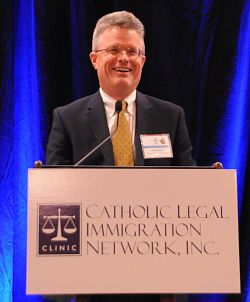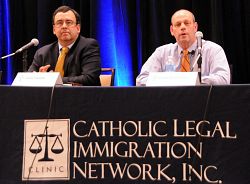Catholic immigration workers meet in Salt Lake
Friday, May. 22, 2015

Intermountain Catholic
Photo 1 of 2
Donald Kerwin, executive director of the Center for Migration Studies, was a plenary speaker at the Catholic Legal Immigration Network, Inc. convention in Salt Lake City. IC photos/Marie Mischel
By Marie Mischel
Intermountain Catholic
SALT LAKE CITY — Catholic Legal Immigration Network, Inc. held its 2015 convention, called a “convening,” in Salt Lake City May 13-15.
Pointing to the 2010 Utah Compact, which advocates for the adoption of a humane approach to the issue of immigration, and the 2012 Salt Lake City Council resolution calling for immigrants – regardless of legal status – to be treated with dignity and respect while being welcomed by residents and community groups, “it really feels like we are among friends here,” said Jeanne M. Atkinson, CLINIC’s executive director, at the plenary.
Two of the plenary speakers were federal officials: León Rodríguez, director of the U.S. Department of Homeland Security’s U.S. Citizenship and Immigration Services; and Juan Osuna, director of the U.S. Department of Justice’s Executive Office for Immigration Review. The third speaker was Donald Kerwin, executive director of the Center for Migration Studies and former CLINIC executive director.
Despite the injunction blocking President Barack Obama’s 2014 executive order to implement the Deferred Action for Parents of Americans and Lawful Permanent Residents program and expand the Deferred Action for Childhood Arrivals program, both Rodríguez and Osuna said they are optimistic about the prospect of comprehensive reform of the United States’ immigration system.
“I want you to know that I am not depressed,” Rodríguez said. “I want you to know that I am not frustrated, and I will tell you why. The goal here, the real justice, will come when we have reform … that gives us a path to citizenship to those individuals.”
The DACA and DAPA programs were on the way to such reform, and “what’s happening now in court, whatever the outcome, begs the question that we must ask our leaders, including me: How would you solve the problem? If Obama’s path is not the path you want, how would you solve the problem? And I think this court case actually causes us to ask that question,” Rodríguez said.
After an encounter with the mother of a college student who is a DACA recipient, Rodríguez said he realized that in the body of laws regulating immigration, “you will never once see the word ‘justice,’” which made him wonder if justice has been pursued in the nation’s immigration system, he said. Enforcement is a common topic, “but I think it’s important that we not stop talking about justice when we talk about immigration,” he said.
Although the injunction against the executive order prevents some action from being taken, “with respect to the undocumented there is plenty of work we can be doing right now,” Rodríguez said. For example, 90,000 young people age into DACA every year, and if CLINIC professionals help them, “we will at least have done something good,” he said.
Every immigration case “is the story of some family’s hopes and dreams and, in many cases, some family’s sufferings,” he said.
The current immigration law was created back in the 1960s and “does not reflect our economy, it does not reflect our demographics,” Rodríguez said; the 9 million people who are eligible to become naturalized citizens must be provided with support so that they can integrate into society in all areas: linguistic, economic and civic, he added
The federal government is working with local governments to promote naturalization, he said, and also is cracking down on “notarios” – those who commit fraud by the unauthorized practice of immigration law.
Rodríguez ended on a positive note, saying, “I believe that as dark as it looks right now, it is really just part of the path to reform that we all know is necessary. … I know that there is a broad national consensus that says that we have to reach reform.”
Similarly, Osuna said immigration reform “is something that has to happen and it will happen.”
Focusing on issues affecting the federal justice department, Osuna said that cases involving the families and unaccompanied minor children who arrived last year at the U.S./Mexican border overwhelmed the courts and, while these cases have been given priority, officials are assessing how to move forward with the process.
Meanwhile, the president’s proposed budget for 2016 includes funding to hire additional judges nationwide, and they also are targeting fraud by notarios, he said.
On a different note, Kerwin said that without comprehensive immigration reform “you’re not going to have a humane enforcement policy.”
An overlooked but vital part of the reform will be to overhaul “the underlying system of legal immigration,” he said. “We shouldn’t have a system where 4.4 million people who are tentatively approved for a visa are waiting for them.”
One obstacle has been the aggressive enforcement of immigration laws, which has led to the expansion of detention centers, he said, and “the overreliance on for-profit prisons to administer this system has created a permanent lobby and supported draconian enforcement and legislation in favor of an ever-expanding detention system.”
Many Americans oppose immigration reform that could be construed as amnesty, saying that it rewards criminals, but undocumented immigrants commit non-immigration offenses at a rate far lower than citizens, Kerwin said.
“Scapegoating immigrants is a tried-and-true political tactic and in the short term it’s often successful, and thus far it has helped to defeat meaningful comprehensive reform,” leading instead to programs like DACA, he said.
Nevertheless, he urged those involved with CLINIC to continue their work.
“Know that you’re on the right side of this fight and ultimately you’re on the winning side of this struggle,” he said, pointing out that 40 million foreign-born people live in the U.S., and “ultimately immigrants and their children are not going to be denied in this country.”
In the short term, they should work to create unity rather than uniformity, “to draw what’s best from these diverse cultures, and to build unity based on the shared values that are embedded in all of them,” Kerwin said.
“Integration often occurs through the pursuit of civic, religious and social values – that is, through the hard work of leadership, work for social justice, service and living out our faith,” he added, and integration “has to address both the displacement and the marginalization of newcomers and the fears and the sense of displacement of some natives.”
For questions, comments or to report inaccuracies on the website, please CLICK HERE.
© Copyright 2024 The Diocese of Salt Lake City. All rights reserved.
© Copyright 2024 The Diocese of Salt Lake City. All rights reserved.


Stay Connected With Us